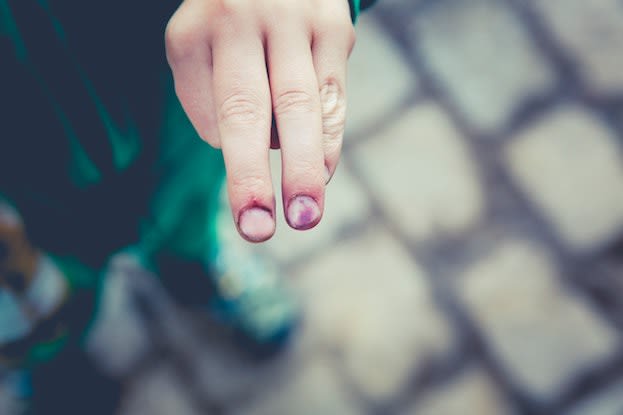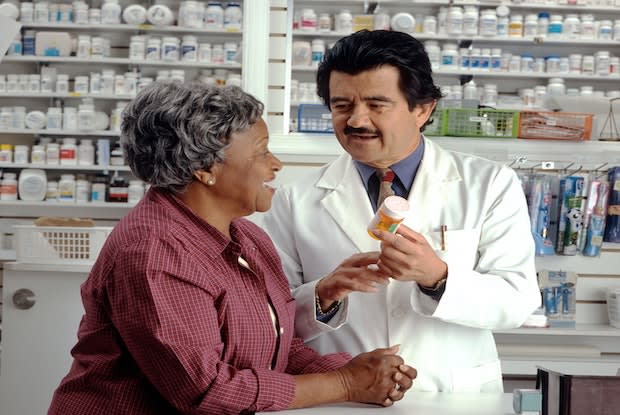Table of Contents
II. Side Effects of Blood Thinners
V. Informing Healthcare Providers
VII. Blood Thinners and Alcohol
What do Blood Thinners Do?
Blood thinners like Xarelto (rivaroxaban), Elmiron (pentosan polysulfate sodium), Coumadin (warfarin), and Eliquis (apixaban) are used to treat those at risk of blood clots. They can improve blood flow in your veins and arteries and prevent blood clots from growing in size. Blood thinners are also used to reduce the risk of clots in various types of heart diseases and heart defects.
By preventing blood clots, blood thinners can reduce the risk of heart attack and stroke. Blood thinners don’t actually thin the blood. Instead, some blood thinners prevent clots from forming by limiting vitamin K production in the liver. Your body needs vitamin K to bind blood cells with platelets to form clots. When vitamin K is reduced, the risk of blood clots reduces accordingly. [1]
Side Effects of Blood Thinners
Blood thinners are effective at preventing clot formations. However, this means your body may be unable to form clots when they are actually needed. Normally, clots seal open wounds and stop them from bleeding too much. If you fall and sustain a bruise while taking a blood thinner, you may experience internal bleeding. [2]
Without the ability to clot, internal bleeding can have severe complications that are hard to notice. Internal bleeding may not show external signs, which is why those who are taking blood thinners should be closely monitored. If you pass blood in your pee or have prolonged nosebleeds that last longer than 10 minutes, you should seek help from a doctor right away. Other symptoms of excessive internal bleeding include: A common complication that can occur while taking blood thinners is gastrointestinal (GI) bleeding. Many people with severe vascular conditions take double doses of blood thinners in an attempt to drastically reduce their risk of stroke. This can often lead to GI hemorrhage without further lowering blood clot risk, so do not increase your dosage without your doctor’s approval. But some patients actually need multiple blood thinners because their condition requires a custom treatment combination. If this is the case, ask your doctor about gastroprotection and anti-ulcer medications to combat bleeding risks from blood thinner side effects. If you are taking multiple blood thinners, your doctor may also prescribe a proton pump inhibitor to decrease stomach acid production. [4] You may also want to prevent excessive bleeding by being careful when mixing medications. Coumadin (warfarin) can interact with antibiotics and antifungals such as cotrimoxazole, cephalexin, penicillin, itraconazole, or ketoconazole. These substances increase the risk of internal bleeding after an injury because they can heighten warfarin’s effectiveness. [5] Always talk to your doctor before adding any medicines or supplements to your treatment. Every time you visit a healthcare provider, you should explain that you are taking blood thinners. For example, let your pharmacist know can help them consider drug interactions when prescribing medications. Telling your dentist can help them make better decisions to avoid bleeding gums and other physical trauma that may result in excessive bleeding. If you are transparent with your doctor, they will be better equipped to make a diagnosis if you are experiencing fatigue, weakness, dizziness, nausea, or shortness of breath. [2] When you take blood thinners, you may have to be extra careful around physical work or activity. Take precautions to limit the risk of falling. You may need to avoid contact sports where you are likely to be kicked or knocked down. Activities such as snowboarding, skiing, or mountain biking are potentially dangerous for those on blood thinners. Depending on your unique risk factors, your doctor can tell you which activities are acceptable. [2] Alcohol is processed in the liver, and so are many medications. If you drink alcohol, your liver may be at a reduced capacity to process blood thinners and the amount of the drugs in your bloodstream can be altered. Blood thinners are highly potent medications, so it is important to monitor everything you consume so you can avoid interactions that worsen your risk of excessive bleeding. [2] While there are many options for blood thinners, you should ask your doctor which one is right for you. Your doctor will need to consider your age, weight, and kidney and liver function before finalizing your treatment plan. Most of the time, the benefits of taking blood thinners outweigh the risks, and it is better to reduce the chances of a heart attack, even if it means taking steps to prevent bleeding scenarios. Ask your doctor about anticoagulants like Xarelto (rivaroxaban), Elmiron (pentosan polysulfate sodium), Coumadin (warfarin), and Eliquis (apixaban) today. The content in this article is intended for informational purposes only. This website does not provide medical advice. In all circumstances, you should always seek the advice of your physician and/or other qualified health professionals(s) for drug, medical condition, or treatment advice. The content provided on this website is not a substitute for professional medical advice, diagnosis, or treatment.
Gastroprotection
Mixing Medications

Informing Healthcare Providers
Avoiding Injuries

Blood Thinners and Alcohol
